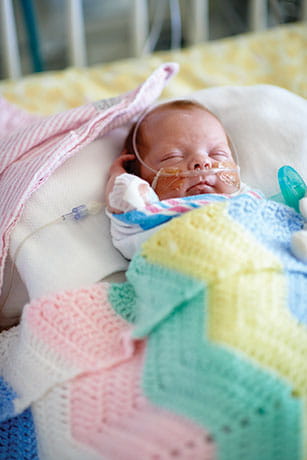Counting the Weeks
New Efforts to Prevent Preterm Birth and Infant Mortality
Doctors and nurses surround a tiny baby in an incubator. The newborn, weighing a mere 2 pounds, is not much bigger than the doctor’s hand.
Born 14 weeks too soon, the baby is not ready to face the world outside her mother’s womb. She’s very sick. In the room, the lights are dimmed to create a soothing atmosphere, but emotions are charged. Complications of preterm birth are the leading cause of infant mortality. Keeping this baby alive will be a struggle. The care team will use every resource of medicine and technology in the intensive care nursery. For the parents and grandparents, there will be tears and prayers, hope and fear. The baby will have to be a fighter.
Sadly, this infant’s story is not unique. Too many babies are born prematurely, and too many die. And beyond the terrible personal and emotional toll, the financial costs are astronomical. Medical care for preemies is 10 to 50 times as costly as the care for full-term babies.
Running a Marathon
Prematurity and infant mortality are complex problems across the country, but they’re an especially vexing problem in our own backyard.
In fact, a 2008 report from the March of Dimes found that Cincinnati had the fourth highest citywide infant mortality rate in the country.
And despite efforts by Cincinnati Children’s and other organizations, we have not made enough progress.
According to data from the Ohio Department of Health, in 2011, 9.2 of every 1,000 babies in Hamilton County died before their first birthday, exceeding the national average of 6.05 deaths. In the city of Cincinnati, more than 13 of every 1,000 died − and in some low-income neighborhoods, the infant mortality rate was even higher.

Dr. Greenberg
A host of factors contribute to prematurity and infant mortality,” explains James Greenberg, MD, co-director of the Perinatal Institute at Cincinnati Children’s. “It takes a long time to change this. It’s a real marathon.”
The year 2013 may be a turning point in the race. A new level of collaboration, investment and creativity is being applied to an old, intractable problem.
Local and national partners are entrusting Cincinnati Children’s with significant new resources to help move the dial.
Finding Innovative Answers
Cincinnati Children’s is the coordinating center for three separate but complementary initiatives that aim to reduce preterm birth and infant mortality. Over $15 million in new funding is being infused into these initiatives.
Like a braid made of strands that cross, these efforts each address a different aspect of the problem and collectively create a new whole.
- We’re launching on-the-ground efforts in two low-income neighborhoods with especially high rates of prematurity and infant mortality. Improvements achieved from this work will be spread across the community.
- Birth hospitals across Hamilton County are collaborating instead of competing, putting new energy behind efforts to build a countywide infrastructure for reducing infant mortality.
- Cincinnati Children’s is leading an innovative collaboration of major pediatric research centers across Ohio. The research will reveal new information about the genetic and sociobiological factors that determine the start of labor.
Targeting High-Risk Neighborhoods
What does the healthcare system look like through the eyes of a young, low-income, single woman who thinks she’s pregnant?
Is seeing the OB/GYN a top priority? Do her friends and family encourage her to make an appointment? Does she have a doctor she knows and trusts? Money for the visit? Transportation to get there? Is she facing more immediate challenges − social isolation, depression, domestic violence, a chaotic or unsafe living situation − that distract her from focusing on the health of her unborn baby?
StartStrong is about understanding the barriers that keep women from getting prenatal care, and learning how to best deliver care and social support to women in high-risk communities.

A planning meeting of the StartStrong program leaders: (L-R) James Greenberg, MD, Judith Van Ginkel, PhD, and Robert Kahn, MD.
Cincinnati Children’s, Every Child Succeeds and TriHealth joined together in 2013 to launch StartStrong. “It will be transformative,” says Judith Van Ginkel, PhD, president of Every Child Succeeds. “It’s being developed hand-in-hand with moms, whose voices and needs are the driving force in the program.”
StartStrong is made possible by a generous $3.2 million grant to Cincinnati Children’s from Bethesda Inc., parent company for the TriHealth hospital system, which includes Good Samaritan Hospital, an active partner in the work. Cincinnati Children’s will contribute another $1 million and will raise an additional $1 million through philanthropy, bringing the funding for this project to more than $5 million.
The program will focus first on women in Avondale and later expand to Price Hill. The two neighborhoods have especially high rates of premature births and infant mortality.
Big Gains from Small Strides
“The babies who are at greatest risk of dying are the ones who are born earliest − the tiny, tiny babies,” says Greenberg. “If we can shift the gestational age even a week, it will make a big difference.”
Babies born at 26 weeks do measurably better than babies born at 25 weeks. Those born at 27 weeks do better than those born at 26 weeks. “In that part of the gestational age range, we can make big gains with what seem like relatively small shifts,” Greenberg explains.
To have the biggest impact, StartStrong will focus on women at highest risk for preterm birth. Some methods that will be tested:
- Expand on the proven services of the Every Child Succeeds program. Be available to all pregnant women, not just first-time mothers. Provide more frequent home visits. Involve more women in moms’ support group meetings throughout the pregnancy and for the baby’s first six months.
- Engage women in prenatal care as soon as they make any contact with the healthcare system. If the woman comes to the doctor for a pregnancy test, offer a same-day prenatal appointment.
- Provide OB/GYNs with a screening tool to help them identify women at highest risk for premature birth. For those women, provide a nurse case manager to stay in touch, answer questions, reschedule missed appointments, coordinate care, and link the women to a medical home and to community resources.
“There’s evidence that these methods will be effective,” says Robert Kahn, MD, MPH, who leads several Cincinnati Children’s initiatives to improve population health, “but we also need to learn from the women we serve. We’ll be doing a lot of listening. We want to better understand how women interact with the healthcare system and what barriers they face, so we can develop a system that works for them.”
With its focus on women at highest risk in two specific neighborhoods and its commitment to testing ideas and measuring results, StartStrong brings new rigor to our community’s fight against prematurity and infant mortality.
Building a Countywide Infrastructure
As StartStrong progresses, a new Hamilton County collaborative will be a resource for spreading the most successful practices to other neighborhoods.
Cradle Cincinnati was developed by Cincinnati Children’s and the University of Cincinnati Medical Center in partnership with city and county leaders.
In June 2013, the participants signed a first-of-its-kind memorandum of understanding agreeing to work together to combat infant mortality.
Hamilton County Commissioner Todd Portune described the agreement as “an historic event in regional collaboration.”
Partners in Cradle Cincinnati include UC Health, TriHealth, Mercy Health, the Christ Hospital, Cincinnati Children’s, the Hamilton County and city of Cincinnati health departments, the University of Cincinnati College of Nursing, and the Center for Closing the Health Gap. Initial funding comes from UC Health.
This unusual partnership includes the major healthcare touch points for pregnant women and their babies − the hospitals where women give birth; the public health and hospital-based clinics where many women receive care; and the emergency rooms and newborn nurseries.
“Hospitals feel a mandate for change,” says Ryan Adcock, program director of Cradle Cincinnati, “and the collaboration provides an unprecedented opportunity to identify care delivery and social support models that work best.”
“Consistent, reliable data is crucial in moving forward,” says Greenberg.
“For the first time, we’ll have a countywide system: uniform definitions, uniform data collection, uniform data reporting, and uniform metrics for measuring success.”
And as evidence confirms the most successful approaches, there will be a system for spreading best practices.
Partnering to Advance Knowledge
StartStrong and Cradle Cincinnati provide a new mechanism to design and implement a more effective system of care for mothers and babies in our community.
Cincinnati Children’s is also leading a large-scale, statewide research collaborative seeking new knowledge to improve health outcomes for newborns.
Funded by a $10 million grant from the national March of Dimes, the Ohio Collaborative involves over 70 investigators at universities and hospitals in Cincinnati, Cleveland and Columbus.

Louis Muglia, MD, PhD, is director of the Center for Prevention of Preterm Birth at Cincinnati Children’s and principal investigator of the Ohio Collaborative.
Unsolved Mysteries
“There are many things we don’t understand about pregnancy and preterm labor,” says Louis Muglia, MD, PhD, director of the Center for Prevention of Preterm Birth at Cincinnati Children’s and leader of the Ohio Collaborative.
Why is the risk of prematurity twice as high for African-American women as for women of European ancestry, regardless of their age, education or income? What causes this racial disparity? Why are stress, poor nutrition and exposure to smoke associated with prematurity?
“Being exposed to stress doesn’t magically start labor,” says Muglia. “And lack of prenatal care doesn’t start it, either. These risk factors have to initiate an underlying physical response that causes labor to happen.”
We don’t yet understand the pathways that are affected by genetic and environmental factors. Now, new tools are being brought to bear on these mysteries.
Advances in genomics and computational biology give today’s researchers an unprecedented opportunity to study the genetics and sociobiology of prematurity.
And in an unusually collaborative effort, the Ohio initiative will utilize the strengths of major research centers across the state.
The investigations are organized into five themes, with researchers at each institution working on each of the projects.
“I believe that over the next five to 10 years we’re going to make discoveries that will change the way we think about pregnancy and preterm birth,” says Muglia. “We have the ability now to ask questions in ways we couldn’t have five years ago. I think we have a phenomenal opportunity to have enormous impact.”
Mid-Course in the Marathon
As promising as the research is, it will take time. It’s a long race to the destination. At the midcourse in the marathon, Cincinnati Children’s is partnering with community agencies, donors and others to build a better care delivery system to improve newborn health now.
As Muglia puts it, “We need to act now using the knowledge we have, and we need to discover more. The problem of preterm birth is too big not to do both.”

Alyssa, born at 30 weeks.






